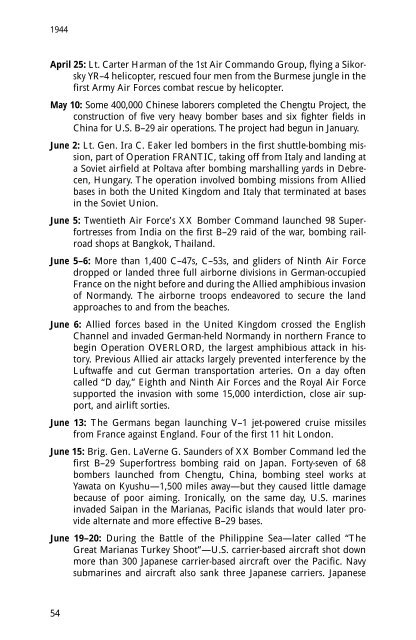One Hundred Years of Flight USAF Chronology ... - The Air University
One Hundred Years of Flight USAF Chronology ... - The Air University
One Hundred Years of Flight USAF Chronology ... - The Air University
You also want an ePaper? Increase the reach of your titles
YUMPU automatically turns print PDFs into web optimized ePapers that Google loves.
1944<br />
April 25: Lt. Carter Harman <strong>of</strong> the 1st <strong>Air</strong> Commando Group, flying a Sikorsky<br />
YR–4 helicopter, rescued four men from the Burmese jungle in the<br />
first Army <strong>Air</strong> Forces combat rescue by helicopter.<br />
May 10: Some 400,000 Chinese laborers completed the Chengtu Project, the<br />
construction <strong>of</strong> five very heavy bomber bases and six fighter fields in<br />
China for U.S. B–29 air operations. <strong>The</strong> project had begun in January.<br />
June 2: Lt. Gen. Ira C. Eaker led bombers in the first shuttle-bombing mission,<br />
part <strong>of</strong> Operation FRANTIC, taking <strong>of</strong>f from Italy and landing at<br />
a Soviet airfield at Poltava after bombing marshalling yards in Debrecen,<br />
Hungary. <strong>The</strong> operation involved bombing missions from Allied<br />
bases in both the United Kingdom and Italy that terminated at bases<br />
in the Soviet Union.<br />
June 5: Twentieth <strong>Air</strong> Force’s XX Bomber Command launched 98 Superfortresses<br />
from India on the first B–29 raid <strong>of</strong> the war, bombing railroad<br />
shops at Bangkok, Thailand.<br />
June 5–6: More than 1,400 C–47s, C–53s, and gliders <strong>of</strong> Ninth <strong>Air</strong> Force<br />
dropped or landed three full airborne divisions in German-occupied<br />
France on the night before and during the Allied amphibious invasion<br />
<strong>of</strong> Normandy. <strong>The</strong> airborne troops endeavored to secure the land<br />
approaches to and from the beaches.<br />
June 6: Allied forces based in the United Kingdom crossed the English<br />
Channel and invaded German-held Normandy in northern France to<br />
begin Operation OVERLORD, the largest amphibious attack in history.<br />
Previous Allied air attacks largely prevented interference by the<br />
Luftwaffe and cut German transportation arteries. On a day <strong>of</strong>ten<br />
called “D day,” Eighth and Ninth <strong>Air</strong> Forces and the Royal <strong>Air</strong> Force<br />
supported the invasion with some 15,000 interdiction, close air support,<br />
and airlift sorties.<br />
June 13: <strong>The</strong> Germans began launching V–1 jet-powered cruise missiles<br />
from France against England. Four <strong>of</strong> the first 11 hit London.<br />
June 15: Brig. Gen. LaVerne G. Saunders <strong>of</strong> XX Bomber Command led the<br />
first B–29 Superfortress bombing raid on Japan. Forty-seven <strong>of</strong> 68<br />
bombers launched from Chengtu, China, bombing steel works at<br />
Yawata on Kyushu—1,500 miles away—but they caused little damage<br />
because <strong>of</strong> poor aiming. Ironically, on the same day, U.S. marines<br />
invaded Saipan in the Marianas, Pacific islands that would later provide<br />
alternate and more effective B–29 bases.<br />
June 19–20: During the Battle <strong>of</strong> the Philippine Sea—later called “<strong>The</strong><br />
Great Marianas Turkey Shoot”—U.S. carrier-based aircraft shot down<br />
more than 300 Japanese carrier-based aircraft over the Pacific. Navy<br />
submarines and aircraft also sank three Japanese carriers. Japanese<br />
54

















